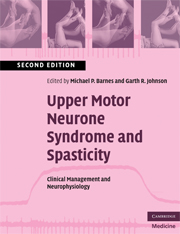Book contents
- Frontmatter
- Contents
- List of Contributors
- Preface to the second edition
- 1 An overview of the clinical management of spasticity
- 2 Neurophysiology of spasticity
- 3 The measurement of spasticity
- 4 Physiotherapy management of spasticity
- 5 Seating and positioning
- 6 Orthoses, splints and casts
- 7 Pharmacological management of spasticity
- 8 Chemical neurolysis in the management of muscle spasticity
- 9 Spasticity and botulinum toxin
- 10 Intrathecal baclofen for the control of spinal and supraspinal spasticity
- 11 Surgical management of spasticity
- 12 Management of spasticity in children
- Index
- References
9 - Spasticity and botulinum toxin
Published online by Cambridge University Press: 22 August 2009
- Frontmatter
- Contents
- List of Contributors
- Preface to the second edition
- 1 An overview of the clinical management of spasticity
- 2 Neurophysiology of spasticity
- 3 The measurement of spasticity
- 4 Physiotherapy management of spasticity
- 5 Seating and positioning
- 6 Orthoses, splints and casts
- 7 Pharmacological management of spasticity
- 8 Chemical neurolysis in the management of muscle spasticity
- 9 Spasticity and botulinum toxin
- 10 Intrathecal baclofen for the control of spinal and supraspinal spasticity
- 11 Surgical management of spasticity
- 12 Management of spasticity in children
- Index
- References
Summary
Introduction
Botulinum toxin (BoNT) is the most potent neurotoxin known, and its clinical effects have been recognized since the end of the nineteenth century. The toxin is produced by the gram-negative anaerobic bacterium Clostridium botulinum and ingestion can produce botulism, a rare and often fatal paralytic illness.
The paralytic effect of the toxin is due to blockade of neuromuscular transmission (Burgen et al., 1949). Injection of BoNT into a muscle causes irreversible chemodenervation and local paralysis. It was this discovery that led to the development of the toxin as a therapeutic tool. It is now used clinically for a wide range of conditions (Jankovic, 1994).
There has been burgeoning interest in the medical use of BoNT, particularly since its efficacy and safety have been demonstrated. Its use in the management of spasticity is now well established. This chapter reviews its mode of action and current therapeutic use in spasticity.
Clinical pharmacology
There are seven immunologically distinct serotypes of botulinum toxin (labelled A to G); there are two types in routine clinical use – BoNT type A (BoNT-A) and BoNT type B (BoNT-B). Most of the studies with regard to botulinum and spasticity have been conducted using type A toxin, but type B toxin is in commercial use and is also used in the management of spasticity.
- Type
- Chapter
- Information
- Upper Motor Neurone Syndrome and SpasticityClinical Management and Neurophysiology, pp. 165 - 180Publisher: Cambridge University PressPrint publication year: 2008
References
- 2
- Cited by

